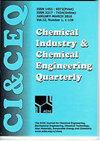由木质素磺酸改性生物聚合物和植物蜡组成的氮肥环保型涂料
IF 0.8
4区 工程技术
Q4 CHEMISTRY, APPLIED
Chemical Industry & Chemical Engineering Quarterly
Pub Date : 2023-01-01
DOI:10.2298/ciceq230214019k
引用次数: 0
摘要
肥料涂层被视为保护肥料颗粒物理质量的强制性措施,由于符合新型肥料类型,最重要的是符合未来环境和动植物健康法规,肥料涂层将继续发展。众所周知,与石油基材料相比,生物基材料具有可持续性和环保性。然而,常见的许多类型的涂料由不可持续的、昂贵的和可能具有生态毒性的内容物组成,如石蜡或矿物油。本文对木质磺酸改性生物聚合物与植物蜡组成的环保防结块涂料替代传统涂料进行了比较研究。本研究的主要目的是寻找替代传统涂料中石油衍生物的替代成分。结果表明,木质素磺酸盐改性生物聚合物防结块涂层改善了硝酸铵钙肥料的颗粒结构,与其他类型的涂层相比,具有最佳的防结块性能。另一方面,植物基涂层在适当的时间间隔内给出了结果,特别是在低浓度下,并且在未来的研究中显示了开发更好版本的有价值的方法。由此可见,生物聚合物可以取代石蜡基产品。本文章由计算机程序翻译,如有差异,请以英文原文为准。
Eco-friendly coatings composed of lignosulfonate-modified biopolymer and vegetable waxes for nitrogenous fertilizers
Fertilizer coatings are seen as mandatory to protect the physical quality of fertilizer granules and they continue to be developed due to compliance with novel fertilizer types and most importantly with future regulations in environment and animal-plant health. As known, the bio-based contents are sustainable and eco-friendly compared to petroleum-based materials. However, there are common many types of coatings composed of unsustainable, costly and can be ecologically toxic contents such as paraffine or mineral oil. In this article, a comparative research study is presented to provide eco-friendly anticaking coatings composed of lignosulfonate-modified biopolymer and vegetable waxes instead of the conventional coatings. The main purpose of this research is to find out the alternative ingredients instead of a petroleum-derivatives in the conventional coatings. According to the results, anticaking coating containing lignosulfonate modified biopolymer showed improvements on granule structure of calcium ammonium nitrate fertilizer and showed the best anticaking performance compared to other coating types. Vegetable-based coatings, on the other hand, gave results in appropriate intervals, especially at low concentrations, and showed a valuable way to develop better versions in future studies. As a result, it is seen that biopolymers can replace paraffin-based products.
求助全文
通过发布文献求助,成功后即可免费获取论文全文。
去求助
来源期刊

Chemical Industry & Chemical Engineering Quarterly
CHEMISTRY, APPLIED-ENGINEERING, CHEMICAL
CiteScore
2.10
自引率
0.00%
发文量
24
审稿时长
3.3 months
期刊介绍:
The Journal invites contributions to the following two main areas:
• Applied Chemistry dealing with the application of basic chemical sciences to industry
• Chemical Engineering dealing with the chemical and biochemical conversion of raw materials into different products as well as the design and operation of plants and equipment.
The Journal welcomes contributions focused on:
Chemical and Biochemical Engineering [...]
Process Systems Engineering[...]
Environmental Chemical and Process Engineering[...]
Materials Synthesis and Processing[...]
Food and Bioproducts Processing[...]
Process Technology[...]
 求助内容:
求助内容: 应助结果提醒方式:
应助结果提醒方式:


